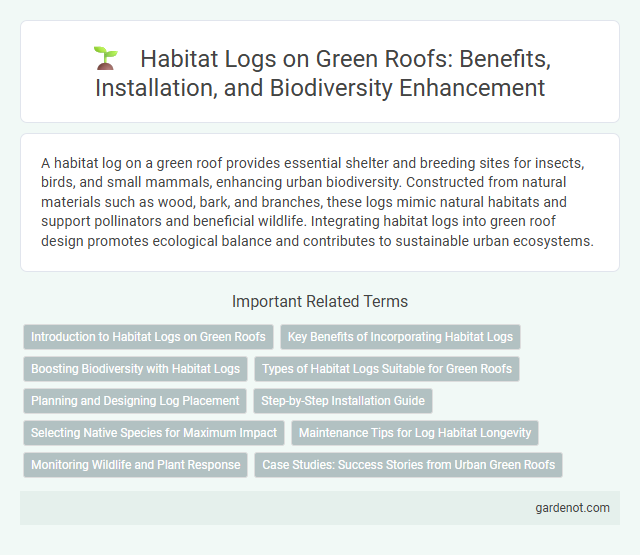A habitat log on a green roof provides essential shelter and breeding sites for insects, birds, and small mammals, enhancing urban biodiversity. Constructed from natural materials such as wood, bark, and branches, these logs mimic natural habitats and support pollinators and beneficial wildlife. Integrating habitat logs into green roof design promotes ecological balance and contributes to sustainable urban ecosystems.
Introduction to Habitat Logs on Green Roofs
Habitat logs are essential components designed to enhance biodiversity on green roofs by providing structured microhabitats for insects, birds, and small mammals. These logs create shelter and breeding sites, promoting ecological balance and supporting native species within urban environments. Incorporating habitat logs into green roof systems improves habitat complexity and contributes to increased urban wildlife diversity.
Key Benefits of Incorporating Habitat Logs
Habitat logs enhance biodiversity by providing shelter and nesting sites for beneficial insects, birds, and small mammals on green roofs. These structures contribute to natural pest control and pollination, improving plant health and ecosystem stability. Incorporating habitat logs supports urban wildlife conservation while promoting a balanced and resilient rooftop environment.
Boosting Biodiversity with Habitat Logs
Habitat logs significantly boost biodiversity by providing essential shelter and nesting sites for insects, amphibians, and small mammals on green roofs. These logs create microhabitats that enhance species diversity and promote ecological balance in urban environments. Integrating habitat logs into green roof design supports local wildlife populations and contributes to sustainable urban ecosystems.
Types of Habitat Logs Suitable for Green Roofs
Habitat logs suitable for green roofs typically include hollow logs, drilled logs, and bundle logs, each offering unique shelter options for pollinators, birds, and insects. Hollow logs with natural cavities support solitary bees and beetles, while drilled logs filled with holes of varying diameters provide nesting sites tailored to specific insect species. Bundle logs, created by bundling smaller sticks or branches, enhance biodiversity by mimicking natural habitats and promoting aeration on green roofs.
Planning and Designing Log Placement
Effective habitat log placement enhances biodiversity by providing shelter and breeding sites for wildlife on green roofs. Strategic positioning considers sun exposure, moisture levels, and proximity to native plants to support various species' needs. Incorporating a mix of log sizes and orientations creates diverse microhabitats, fostering a resilient rooftop ecosystem.
Step-by-Step Installation Guide
Habitat Log offers a clear step-by-step installation guide for green roofs, enhancing urban biodiversity and improving insulation. Begin by preparing the roof surface with a waterproof membrane, followed by installing the root barrier and drainage layer to protect the structure. Next, add the lightweight growing medium before planting diverse vegetation suited for local climate conditions, ensuring long-term sustainability and ecological benefits.
Selecting Native Species for Maximum Impact
Selecting native species for habitat logs enhances biodiverse ecosystems by providing optimal food and shelter suited to local wildlife. Native plants support pollinators, birds, and beneficial insects, promoting balanced ecological interactions within green roofs. Choosing species adapted to regional climate and soil improves survival rates and sustainability, maximizing habitat effectiveness.
Maintenance Tips for Log Habitat Longevity
Regular inspection and removal of debris prevent mold and insect infestations in habitat logs used in green roof ecosystems. Applying natural preservatives like linseed oil extends the log's durability against weathering and moisture. Positioning the log to ensure proper drainage minimizes rot, sustaining its role as a functional habitat for beneficial wildlife.
Monitoring Wildlife and Plant Response
Habitat log systems enable precise monitoring of wildlife activity and plant response on green roofs, capturing real-time data on species diversity and vegetation health. Advanced sensors track temperature, moisture, and growth rates, providing critical insights into ecosystem dynamics. This data supports adaptive management strategies to enhance biodiversity and optimize green roof performance.
Case Studies: Success Stories from Urban Green Roofs
Habitat Log highlights success stories from urban green roofs that demonstrate significant benefits in biodiversity enhancement and microclimate regulation. Case studies reveal diverse species thriving on rooftops in cities like Chicago and Singapore, showcasing green roofs as vital urban habitats. These documented examples emphasize the ecological value and sustainable impact of integrating vegetation into urban infrastructure.
Habitat log Infographic

 gardenot.com
gardenot.com